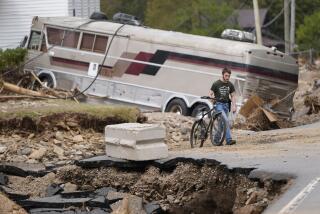After Deadly Sweep of Florida, Irene Rolls Up to Traumatized N. Carolina
- Share via
WILMINGTON, N.C. — Leaving six people dead in Florida and hundreds of thousands without power, Hurricane Irene rumbled up the East Coast on Saturday, taking aim at flood-weary North Carolina.
Residents there began all-too-familiar preparations for another onslaught while officials considered evacuations and warned that it wouldn’t take much rain to push rivers in the eastern part of the state back above flood stages. Irene’s 80 mph winds also could threaten camper villages populated by people left homeless by the floods.
The forecast--landfall in Wilmington, N.C., tonight--could not have been more grim for the Wilmington area and other parts of eastern North Carolina that have barely begun to recover from the ruin brought by two visits from Hurricane Dennis earlier in the season and Hurricane Floyd’s historic flooding last month.
Gov. James B. Hunt Jr. declared a state of emergency.
Paul Buday, whose government-provided camper is parked in his soggy yard, wore rubber gloves and boots Saturday as he hauled sodden carpeting and furniture to the street. Floyd left water 16 inches deep in his brick home across the street from the Neuse River near Goldsboro, but Buday wasn’t fretting about Irene just yet.
“Right now it doesn’t worry me, but I don’t know what I’ll feel like tomorrow,” Buday said. “The river’s down. I don’t think we’ll have a problem.”
So far, the storm has been blamed for at least eight deaths--two people in Cuba, five near Fort Lauderdale, Fla., who were electrocuted by downed power lines, and a man whose body was found in a canal near Fort Lauderdale. After drenching Cuba’s tobacco fields and causing buildings to collapse in Havana, Irene rolled ashore Friday afternoon 75 miles southwest of Miami and headed north through the Everglades.
Irene’s deluge left South Florida coping with a flood of standing water. Canals overflowed, streets were knee-deep in water and a major roadway connecting the state’s east and west coasts was closed by flooding.
At its worst, the storm knocked out power to more than 1.5 million customers, according to Florida Power & Light Co., the state’s largest utility. Electricity was restored to about half of them by midday Saturday. As much as 18 inches of wind-driven rain caused scattered flooding over hundreds of miles, from Key West to West Palm Beach.
Irene intensified slightly as it headed north. Its 80 mph sustained winds were 6 mph more than the threshold for a hurricane and the storm was moving north at 12 mph.
At 5 p.m. EDT Saturday, the center of the storm was about 285 miles south of Charleston, S.C., and moving north at about 10 mph.
Projections from the National Hurricane Center put the ragged eye of the storm near Cape Romain, just northeast of Charleston, by this afternoon.
It was exactly a month ago Saturday that thousands of coastal residents returned home after fleeing Hurricane Floyd, which destroyed more than 6,000 buildings and damaged 9,000 others. At least 49 deaths, and damage expected to exceed Hurricane Fran’s record $6 billion in 1996, were attributed to that storm. Piles of soggy furniture and ruined toys and appliances still line roads throughout the region.
Rain was already falling in southeastern North Carolina on Saturday afternoon.
“There’s no place for this rainfall to go, so any little bit of rain that we get from this hurricane could immediately cause flooding,” said Laura Furgione, a meteorologist at the National Weather Service office in Newport on the central North Carolina coast.
A hurricane warning was in effect from Savannah, Ga., to Cape Hatteras, N.C., and a hurricane watch was posted for north of Cape Hatteras to the Virginia border. A tropical storm warning remained in effect north of Vero Beach, Fla.
Emergency management officials discussed possible evacuations in Brunswick and New Hanover counties, N.C., where the hurricane warnings were in effect, and visitors were ordered off the Cape Lookout National Seashore.
Officials opened shelters to evacuate hundreds of residents who had moved to campers set up as temporary housing for people whose homes were ruined by Floyd’s floods.
The state was mobilizing 300 National Guard troops Saturday to prepare for the recovery effort, and Eric Tolbert, North Carolina’s emergency management director, said many supplies are already in place because of the recovery effort from Hurricane Floyd.
“I’m a little concerned about personnel resources being strained,” Tolbert said. “Our personnel are obviously tired.”
More to Read
Sign up for Essential California
The most important California stories and recommendations in your inbox every morning.
You may occasionally receive promotional content from the Los Angeles Times.












